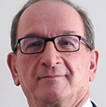Current Affairs
Celebrity chef Gordon Ramsay has relocated his restaurant headquarters from California to Texas, Dallas Morning News reported.
Ramsay has hired a team of businessmen and chefs to expand his restaurant brand across North America, the outlet reported. It added that the team, which will be based in Las Colinas, plans to launch 18 restaurants in cities including Boston, Miami, and Chicago.
The CEO of Gordon Ramsay North America, Norman Abdallah, will oversee the opening of 75 company-owned restaurants across the country in the next five years, according to Dallas Morning News.
The availability of chefs and restaurant support staff, as well as the favourable tax policies, are what attracted them to Dallas, Abdallah told the outlet. “The cost of living adjustment [from California to Texas] is pretty substantial,” he added…read more.

Decentralised finance happens to be one of the few high tech areas where the EU is doing quite well. Last week the Council adopted its position on proposed crypto market regulations for Defi products. They are very industry-friendly.
The proposed regulations are the most important to date for the European crypto industry because they establish rules for issuers, or the developers and companies behind tokens, as well as crypto-asset services providers, or exchanges and custodians.
Happily for the EU industry, the new regulations do not apply to non-fungible tokens, NFTS. Nor do they apply to utility tokens, meaning any crypto asset that provides access to a good or service provided by the issuer. Crypto-assets that are offered for free, airdrops, are also exempt. Crypto assets automatically created as a reward for maintaining the blockchain on which they operate are also unregulated.
It’s a different story for stablecoins. The EU remains attached to the idea of launching its own central bank digital currency. Whether pegged to a fiat currency or basket of currency or assets, any form of stablecoin will be under strict regulation including a ban on earning interest, and a requirement for all issuers to be granted permission by the relevant national authority.
Fully decentralised exchanges are not subject to these rules, most likely because, as we’ve been arguing, it would be impossible to enforce them.
In another pleasant surprise for the industry, self-custody software and hardware wallets do not fall under the new regulations either. Earlier announcements that the EU planned to ban anonymous wallets appear to have been premature: there seems to be a growing recognition in the EU of what is and is not possible in Defi and crypto…read more.

Canada’s central bank will maintain its current inflation target of two per cent, but will rely more on employment numbers to make policy decisions.
Since 1991, the Bank of Canada (BOC) has tried to keep inflation within one to three per cent, ideally at two per cent.
On Monday, it renewed its current inflation mandate with the federal government, which it does every five years.
The new focus of the latest agreement is supporting “maximum sustainable employment,” which is the highest jobs rate the economy can handle before inflation pressures kick in. The renewed mandate gives the bank added flexibility to adjust its policy to changing labour conditions.
Speaking to reporters in Ottawa, Finance Minister Chrystia Freeland said the bank can’t target inflation and employment at once.
“We are very explicitly … choosing not to do (a dual mandate),” she said Monday. “We are very clear in the mandate renewal that the paramount objective of the BOC is its inflation target of two per cent, within a one to three per cent band.”
Canada’s inflation skyrocketed to 4.7 per cent in October, the highest it’s been in nearly 20 years. The bank’s job is to adjust inflation to meet its target. It does this by either raising interest rates to cool inflation or cutting them to encourage spending and borrowing…read more.

Bullish enthusiasm came roaring back this week – the S+P registered an All-Time High close – the DJIA rallied >2,000 points from last week’s lows
The S+P hit All-Time Highs Monday, November 22, but closed down on the day. Three sessions later, waves of heavy selling in illiquid conditions on Thanksgiving Friday caused the index to close 163 points below Monday’s high – the biggest down week since January (and a Weekly Key Reversal Down on the chart.)
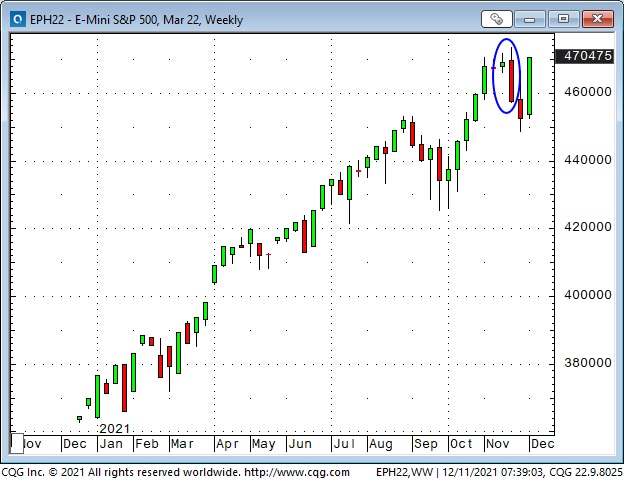
The following week saw violent intra-day price swings. Late in the day on Friday, December 3, the S+P traded ~250 points below the previous week’s highs, volatility levels had soared to near the highest levels YTD – and then, the tide turned, the index bounced and closed ~40 points off its lows.
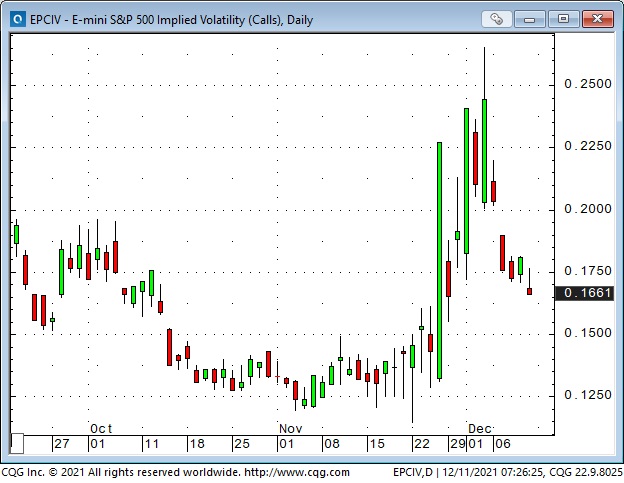
The Sunday, December 5th afternoon futures session opened higher, and by mid-morning Tuesday, the S+P had rallied ~170 points from Friday’s lows. The market chopped sideways within a narrow range the next three days, and Friday registered an All-Time High close (~27 points below the November 22 ATH.)
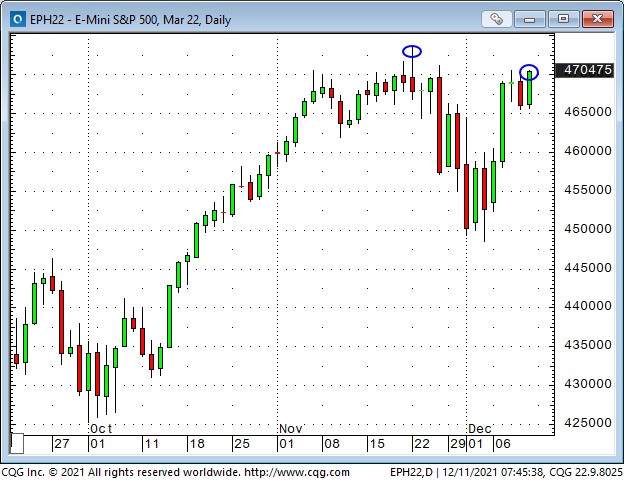
The “cash” DJIA (not the futures) registered a big “Island Reversal” on the charts. Some folks see that as a bullish pattern.
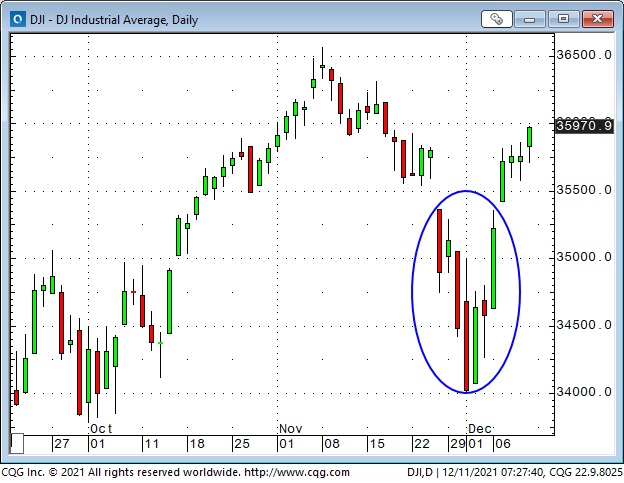
AAPL surged to New All-Time Highs this week with a market cap of ~$3 Trillion – up ~ $500 Billion from month-ago levels. (See a great list of global company market caps at https://companiesmarketcap.com/)
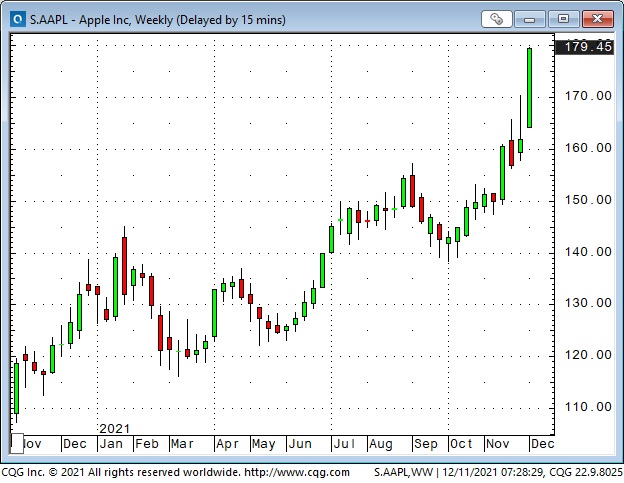
ARKK (last year’s darling) is down ~44% from its February highs – while the S+P is up ~18% since mid-February.
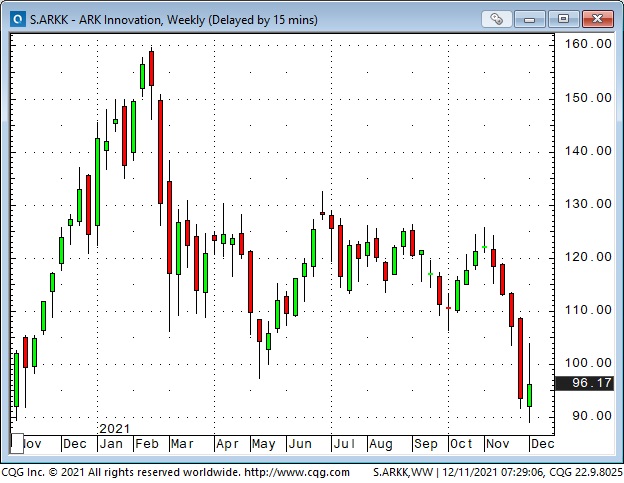
Concentration
Everybody knows that a handful of Big Cap tech stocks account for ~25% of the weighting of the S+P 500 – but here’s another look at concentration: The Nasdaq total YTD return is ~21%. Five stocks (AAPL, MSFT, GOOGL, TSLA, NVDA) account for ~2/3 of those returns. The Nasdaq total YTD return is less than 6% without those five stocks.
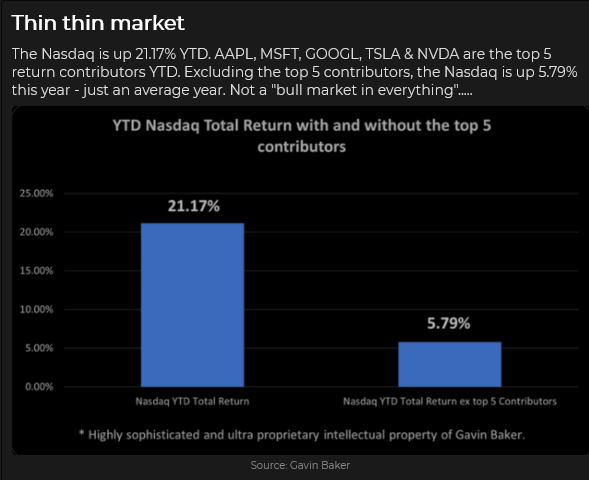
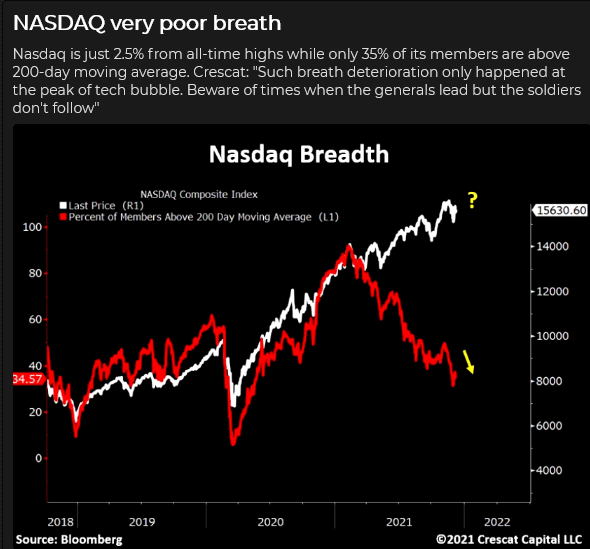
Passive capital flows boost Big Cap stocks
One of the reasons Big Cap companies keep getting bigger is that a tidal wave of money has flowed into the markets this year. More than half of that money has gone into passive investments, which track/mimic the indices. (There has also been a flow of capital leaving actively managed investments for passive investments.)
The PMs who “manage” passive funds allocate money according to the index weightings. So, for every dollar of new money they invest in S+P tracking funds, ~16 cents goes into AAPL, MSFT, and AMZN. It’s a bit like a perpetual motion machine; the more money coming in, the bigger the biggest cap stocks get relative to other stocks.
Active capital flows boost options volume (and meme stocks)
The smaller half of the tidal wave of money flowing into the markets goes into “active investments.” This covers everything that is not “passive” and includes both managed and self-directed “investments.” “Active” could range from old-fashioned mutual funds with stock picking, “value-seeking” portfolio managers to YOLO kids rolling the dice on short-dated OTM options.
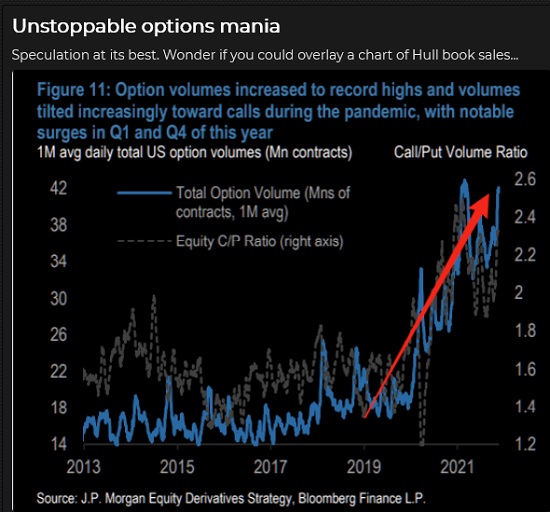
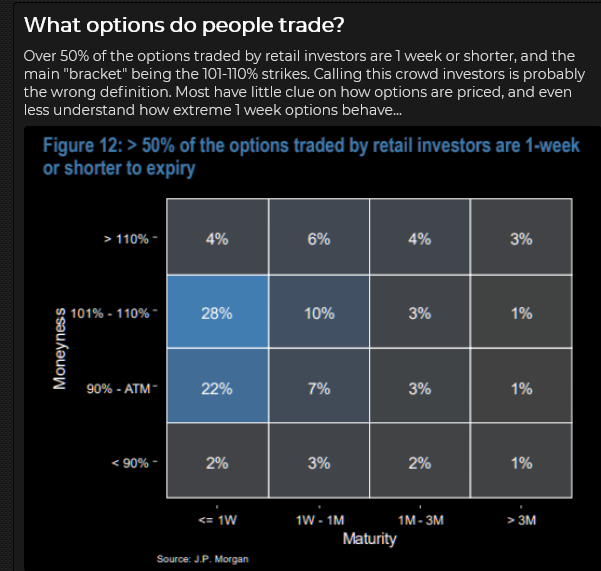
Interest Rates
Prices of long-dated Treasuries have been trending higher for the past several weeks (yields have been falling), and they rose to new YTD highs when the stock market rattled investors’ nerves last week. With the stock market rising this week, bond prices fell.
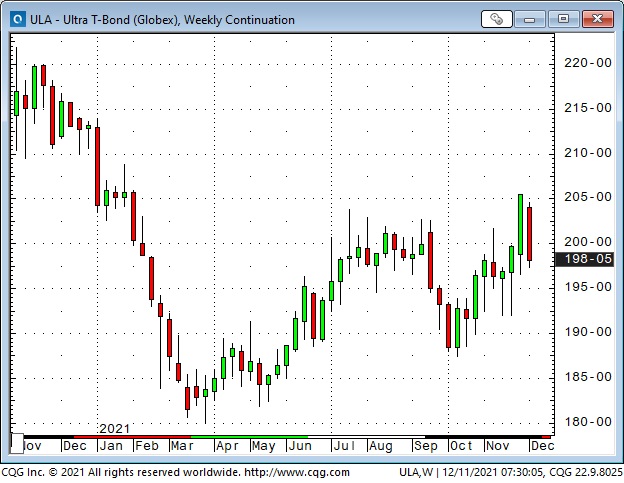
With the CPI at 6.8% and the ten-year Treasury yield at 1.47%, the 10 Year Real Yield = negative 5.33%. This is not the best “measure” of inflation (for instance, the 10-year Tips/Treasury breakeven rate is 2.52%), but MSM will feature this (sensational) number.
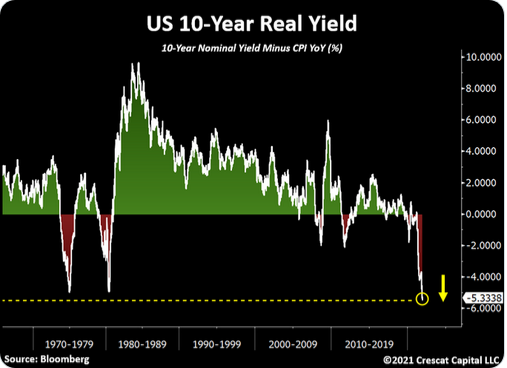
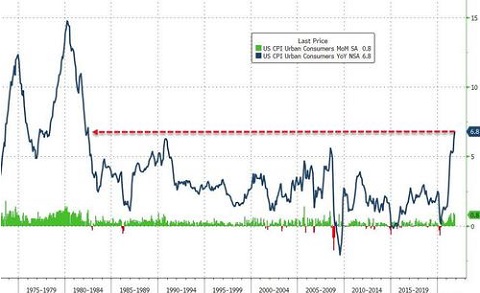
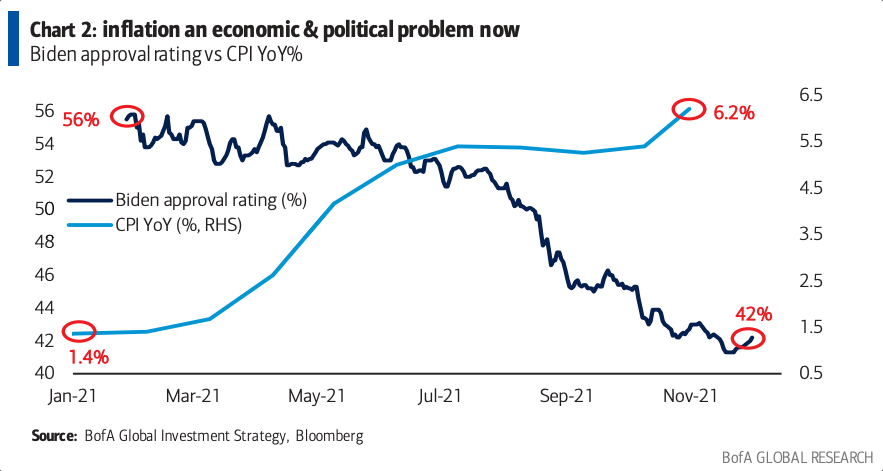
Currencies
The US Dollar Index has been relatively steady at ~96 for the past four weeks, a 16 month high. Speculators have accumulated the largest net long USD position in the currency futures market since June 2019.
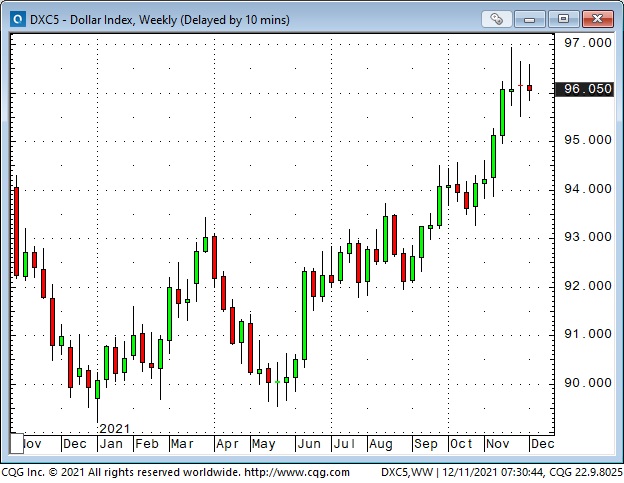
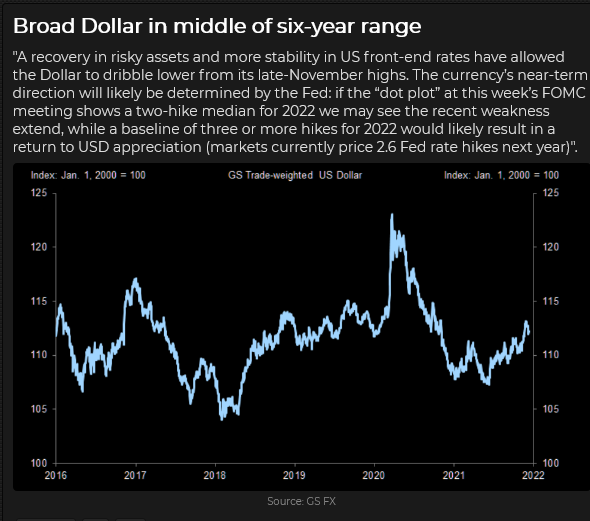
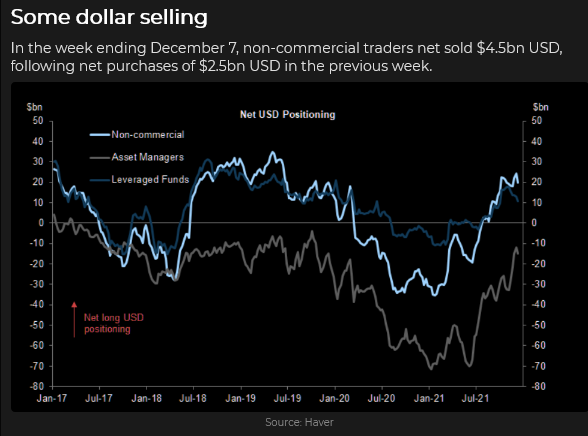
The Canadian Dollar fell for six consecutive weeks as the USD rallied and commodities (especially crude oil) fell, but it bounced a bit this week (WTI rallied ~$10 from last week’s lows and stock markets surged higher.)
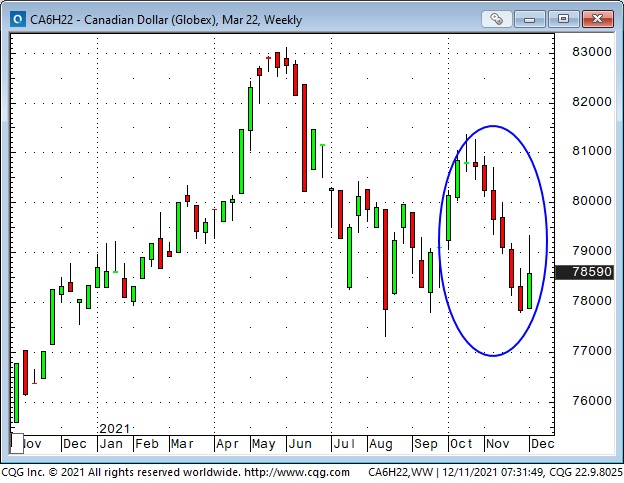
The CAD may have rallied ahead of Wednesday’s BoC meeting in anticipation of a more hawkish tone, but that hawkish tone was not forthcoming, and the CAD fell Wednesday through Friday.
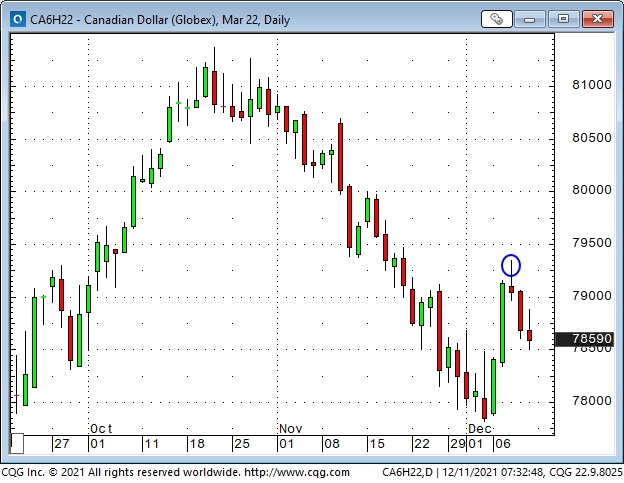
Commodities
The broad Goldman Sachs Spot Index reached a 7-year high in October as crude oil hit a 7-year high. The index drifted lower and then took a sharp drop late in November as WTI crude extended its decline from ~$85 to ~$62. The index bounced back the past few days as investor sentiment improved and WTI bounced ~$10.
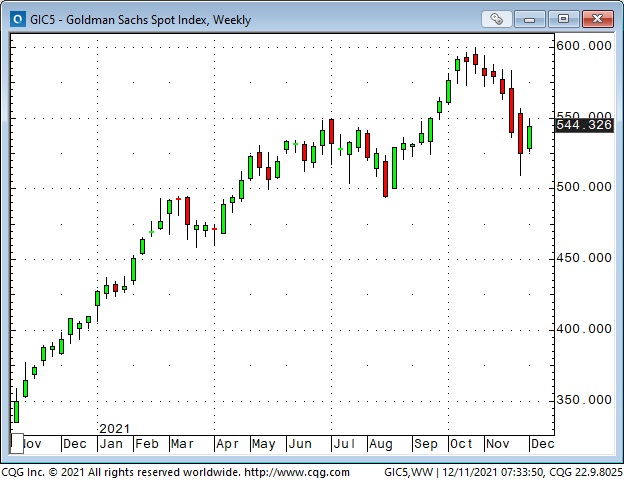
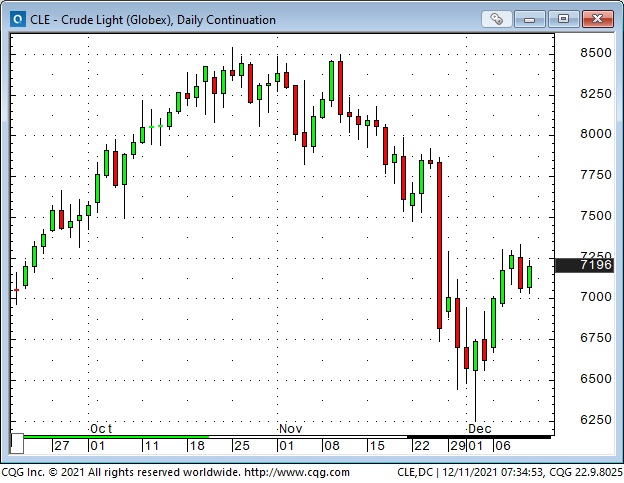
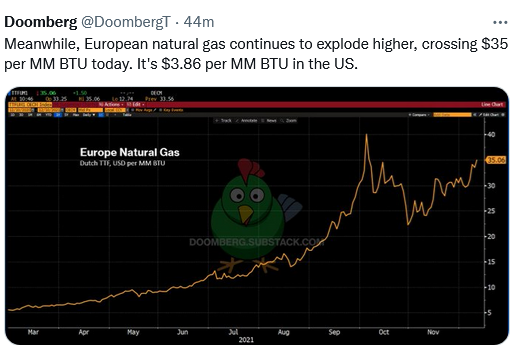
My Short-Term Trading
Last week I bought the S+P and the CAD a few times – expecting investor sentiment to bounce after the sharp tumble that began on Thanksgiving Friday. Net, net my P+L was down ~0.50% on the week. I was early on my “rebound” call.
As noted above, the S+P made its low last week late Friday and rallied ~40 points into the close. When the market opened higher Sunday afternoon, I maintained my BTD mentality, but I waited for the Monday day session (for confirmation) before buying the S+P.
The market rallied during the Monday day session and soared in the overnight session. I covered the trade mid-day Tuesday for a gain of ~120 points (roughly equivalent to ~1,200 Dow points.)
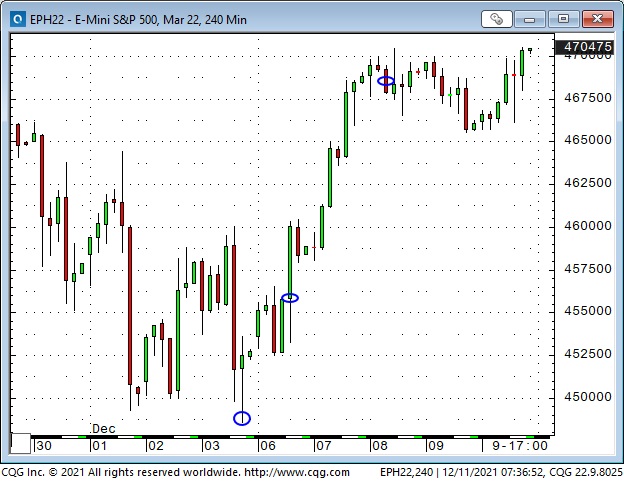
I shorted the S+P a couple of times later in the week, thinking the market had rallied too far, too fast, but I was stopped for small losses on those trades.
I shorted the CAD when it fell back following the Wednesday BoC meeting. I’ve remained short CAD, which is the only position I hold going into the weekend. My P+L is up ~1.25% on the week, not counting unrealized gains on the short CAD.
On my radar
I’ve generally been bullish on the USD this year, but I haven’t capitalized on that view. (There is always room for improvement in trading!) Over the years, I’ve noticed that currency trends often go WAY further than what seems to “make sense,” and then turn on a dime and go the other way. Those reversals often happen around the end of the year, so I’ll watch for that over the next month or two.
Too many people believe that it’s easy to make money buying stocks – so we may see a correction there.
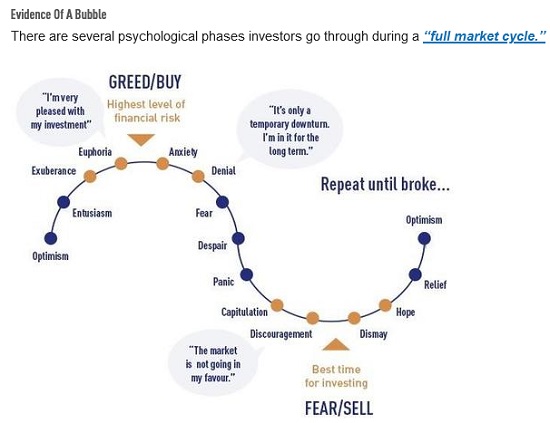
Thoughts on trading
Stories: Last week I wrote that I don’t like to “buy” stories. For instance, I don’t want to buy copper (simply) because the “story” says electrification demand and limited new mine supply automatically means that copper prices will go up.
That doesn’t mean that I ignore stories. Stories have a life cycle, and I think it is essential to know where they are in their cycle. For instance, George Soros liked to say that when he saw a bubble forming, he bought the market in anticipation of the bubble growing and taking prices much higher.
I’m skeptical of stories because they cause people to focus on the “why” to buy rather than the “when” to buy. A good story is also seductive, which may encourage poor risk management practices – and I genuinely believe that good risk management contributes more to long-term trading success than any crystal ball.
When I hear a good story my first thought is always: “Who doesn’t already know that?”
Wizards: In the past two weeks, I’ve referred to the RTV interview Jack (Market Wizards) Schwager recently did with Peter Brandt. In that interview, Jack talks about what the “Wizards” have in common. He said that most of them started their trading career with poor performance, and it took years for them to “find their way” to becoming super successful, and they had to change their methodology as markets changed.
Jack also noted that some wizards had no problem managing other people’s money. Other wizards could not do it – they felt bad/guilty every time they took a loss, which killed their ability to trade freely.
Reminiscences: My bedtime reading lately has been Reminiscences Of A Stock Operator by Edwin Lefevere. I bought my first copy of that book more than 40 years ago (it was written over 100 years ago) and I have re-read it every couple of years. I had forgotten how good it is. It is the story of a trader learning how to trade (he “reads the tape“) but at another level, it is a fantastic and very honest, story about The Trading Life. I recommend it to you.
Quotes from the notebook
“It is normal/typical to think, “I’ve missed the move…I can’t buy it here after it has rallied so much!” But most money is made not by picking bottoms but by going with the trend and especially as the trend accelerates near the end of the move.” John Burbank, RTV interview with Alex Gurevich 2019
My comment: I picked this quote because I wish I were more like that! Some guys make it look easy!
When a market is going down, you have no idea how far down, down is!
It’s not a problem until it’s a problem, and then it’s really a problem.
There is never just one cockroach.
Do more of what is working and less of what is not working.
Dennis Gartman, many times, over the years
My Comment: Dennis was a trader in the old “South Room” at the CBOT, trading GNMAs and T-Bonds, in the late 1970s when I first visited the Chicago trading floors. I didn’t meet him then – we didn’t meet until the early 1990s (when his daily letter used to come by fax), and we became good friends over the years. He put a lot of work into writing his daily letter and passed along many good insights and observations – such as the quotes above.
A Small Request
If you like reading the Trading Desk Notes, please do me a favour and forward a copy or a link to a friend. Also, I genuinely welcome your comments. Please let me know if there is something you would like to see included in the TD Notes. Thanks, Victor
Barney is getting ready to show me around the golf course.

Victor Adair retired from the Canadian brokerage business in 2020 after 44 years and is no longer licensed to provide investment advice. Therefore, this blog, and everything else on this website, is not intended to be investment advice for anyone about anything.

Bitcoin’s massive swings aren’t for everyone, but one investing shark is hungry for more cryptocurrency: Kevin O’Leary.
The O’Shares ETFs chairman and Shark Tank personality bought his first coin in 2017 and has been picking up speed ever since.
“I’ve grown the portfolio remarkably,” O’Leary told his audience during a Reddit Talk session last month.
“At the beginning of the year, I was at 3% weighting. The target was to get 7% by year-end. However, because of the appreciation of so many of the assets I have now, we’re almost at 10% today.”
However, O’Leary’s largest investment fund, O’Shares U.S. Quality Dividend ETF (OUSA), doesn’t invest in crypto at all. Instead, it seeks businesses with strong profitability, balance sheets and dividend growth.
If you’re looking to diversify your crypto-heavy portfolio with income-producing stocks, take a look at the top three holdings of O’Leary’s flagship fund. And if none of those appeal, O’Leary also invests in plenty of alternative assets…read more.




